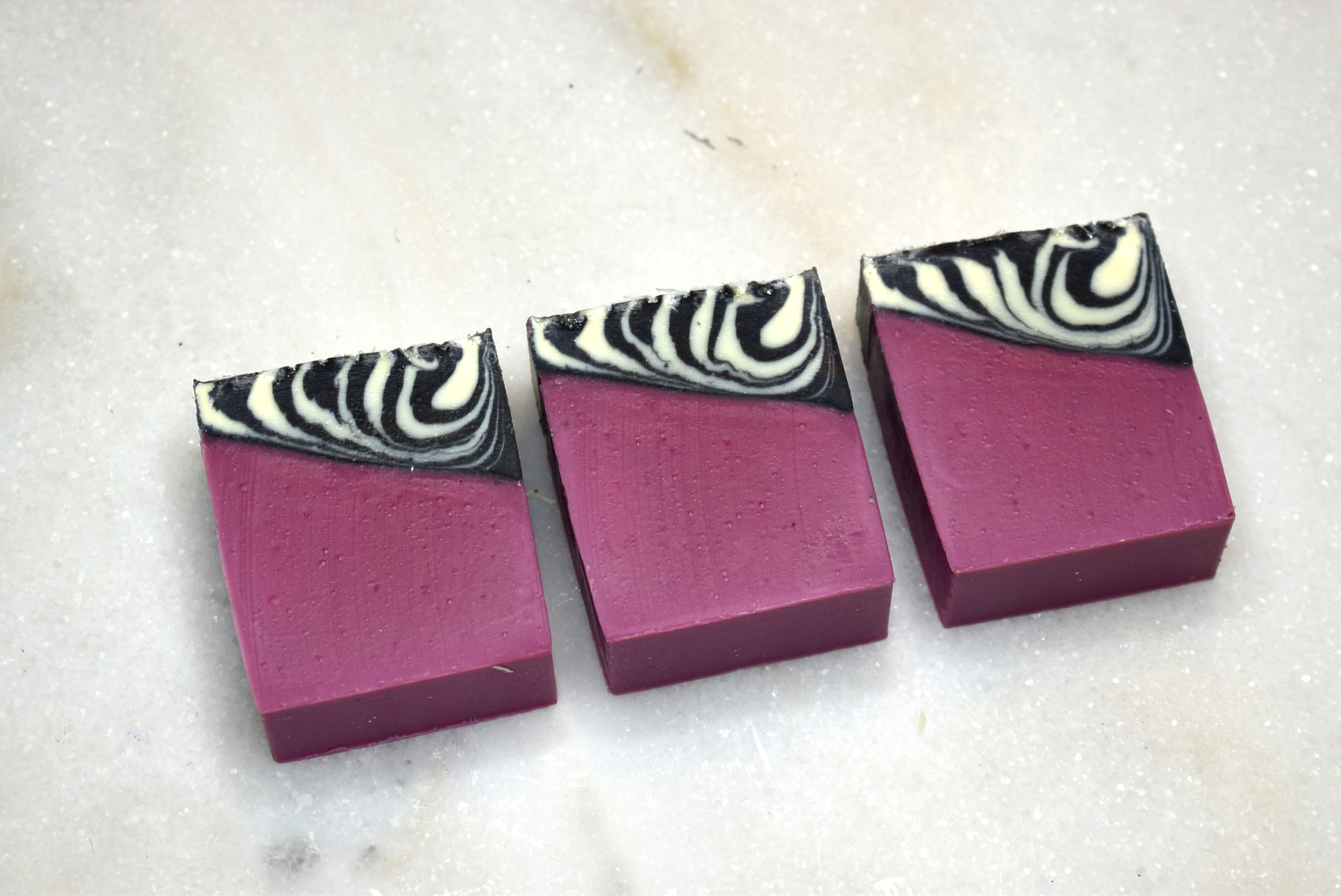Now that you’ve gotten good at making soap, you might be thinking about selling! Great!
Here are some tips and resources for labeling your soap. (Please note that this applies to those selling soap in the U.S. only. Other countries have different requirements and standards.)
Several defining questions about the soap must first be answered. How was the soap made? What claims are made about the soap?
So, let’s break defining soap categories down:
- Cold and hot process soap: According to FDA cosmetic regulations, this product is one in which “the bulk of the non-volatile portion consists primarily of an alkali salt of fatty acids.” In simple terms, fully cured soap made with lye and oils. Let’s call this JUST SOAP.
- Melt and pour soap: Most, if not all, melt and pour soaps are considered cosmetics based on their ingredients (detergents). Let’s call this SOAP AS A COSMETIC.
- Cold and hot process soap with cosmetic claims made: Claims such as moisturizing, or any claim of beautification of the skin, throws the soap into the category of cosmetic category. Let’s call this SOAP AS A COSMETIC as well.
- Soap with prevention or cure claims: Claims of disease or skin condition prevention, including claims such as acne and eczema prevention, moves the soap into the drug category. Let’s call this SOAP AS A DRUG.
- Soap with insect repellent claims: Claims that a soap helps to repel insects, moves the soap into the insecticide category. Let’s call this SOAP AS AN INSECT REPELLENT.
If this seems daunting, don’t fret.
Ingredients Declaration for JUST SOAP
Marie Gale, author, soap and cosmetic labeling expert, states at her blog Ingredient Labels for Soap, “Sometimes (often, actually) a soapmaker has a true soap for which no cosmetic claims have been made, but still wants to tell their customers what is in the soap. Since it’s not a cosmetic, the FDA regulations don’t apply, so there is considerably more freedom in what you say. In this case, you could use “saponified oils of ___”. The ingredients don’t necessarily have to be in descending order of predominance – they don’t even have to all be included.”
You don’t even have to include any ingredients on your label.
So, in our words, labeling soap ingredients is not a requirement per FDA regulations, it is a soap maker’s option.
The only claims that you can make about JUST SOAP is that it cleans and that it is simply soap. You can’t call it moisturizing or exfoliating. You can’t claim that it clears eczema.
Many soapmakers get up-in-arms when other soap companies don’t list certain ingredients (such as lye) or list their ingredients using saponified oils of….
They aren’t doing anything wrong according to what they can get away with. So focus on how you want to label your soap and communicate your ingredients to your customers.
Here are some examples of ingredients declarations for JUST SOAP.
“Saponified 100% food grade olive, coconut, palm & castor oils in a goat’s milk base, with pure essential oils, and seaweed.” (Zum Bar)
“Sodium Palmate, Sodium Cocoate, Sodium Olivate, Sodium Avocadate, Activated Bamboo Charcoal, Citrus sinensis (Orange) Essential Oil, Lavandula (Lavender) Essential Oil, Rosmarinus officinalis (Rosemary) Essential Oil” (Slab Soap)
“Saponified Organic Oils of Palm, Coconut, Olive and Palm Kernel, Natural Lavender Essential Oil Blend, Organic Lavender Blossoms, Organic Rosemary Extract” (Vermont Soap)
Ingredients Declaration for SOAP AS A COSMETIC
Let me start off by saying that this is how I prefer to label soap. I wish our entire industry would label soap this way. It tells consumers exactly what is in a product so that they can make an informed decision to purchase it or not. It is helpful if people are allergic to certain ingredients.
Labeling cosmetics, including any “soap” that is categorized as a cosmetic according to the FDA, falls under the regulations here. To clarify this for you, label the cosmetic ingredients (if the ingredient is greater than 1% of the formula) in descending order of proportion. List the ingredient’s common name. If the ingredient is less than 1% of the formula, include the ingredient at the end of your cosmetic list, in any order.
Common name – Many soapers (including myself at one time!) think that you have to include the INCI name in your cosmetic ingredients listing. You don’t. You can simply use the common name and if you want to include the INCI name, you can add that in parenthesis beside each common name. For more info on the common name of ingredients, check out Marie Gale’s blog post here.
Here is an example of an ingredients declaration for a SOAP AS A COSMETIC. Ingredients are listed in descending order using common names.
“Organic Coconut Oil*, Organic Palm Oil*, Sodium Hydroxide**, Water, Organic Olive Oil*, Mentha Arvensis, Organic Hemp Oil, Organic Jojoba Oil, Mentha Piperita, Sea Salt, Citric Acid, Tocopherol
*CERTIFIED FAIR TRADE INGREDIENTS
**None remains after saponifying oils into soap & glycerin.” (Dr. Bronners)
I don’t recommend making and selling SOAP AS A DRUG or SOAP AS AN INSECT REPELLENT so won’t go into labeling those. You have to go through many more hoops/testing, etc. to sell a drug or insect repellent. Just be aware that the claims you make can put your soap into the categories and can land you in trouble.
So on a soap label, here is what you’ll need.
JUST SOAP – Identity of the product (in this case soap), net weight, name and address of the manufacturer. (No ingredients necessarily need to be listed.)
SOAP AS A COSMETIC – Identity of the product (in this case soap), net weight, name and address of the manufacturer and ingredients.
- Net Weight – Check out this blog post by Marie Gale to see what is required.
- Address of the Manufacturer – Check out this blog post by Marie Gale to see what is required.
Additional points to be aware of:
When a soap maker claims the function of a single soap ingredient, such as calming aromatherapy claims of lavender oil, this categorizes the soap as a drug. Even if the soap label does not include these claims, using this verbiage in other areas of the soap business, such as, marketing materials, published reviews, or a blog, leads to the requirement to label the soap as a drug.
When listing soap colorants (or any soap ingredient), be careful to not claim that the soap is “colored naturally by” (fill in the blank: lavender, herbs, plant material), unless that ingredient is approved by the FDA as a colorant. Include ingredients on a label, or any written materials, by their common name, not by the purpose that they fill.
If you make things like bath bombs (or other cosmetics) check out this info from Joanna (Soap Bar Blog). FDA Regulations Regarding Color Additives In Cosmetics and this blog post from Marie Gale.
Making Claims
By the way, and this is a big one…you have to be careful what you say about your soap and where. If you are claiming and labeling your soap to be JUST SOAP but post on Facebook about your moisturizing or exfoliating soap, you are making a claim that would then put your soap into the cosmetics category.
If you you post a customer review to your website or social media that claims your tea tree and charcoal soap cleared up their acne, you are putting your soap into the drug category (even though it wasn’t you that made the claim).
Many soapers don’t realize this. Possible claims can be made on: social media, customer reviews, marketing materials, packaging and by your mouth.
Customer reviews? Yep! This is what gets soapmakers (and other product makers) in trouble. They think that they can’t say their product does a certain thing but if a customer says it, it is okay. This simply isn’t true. By publishing the customer’s review, you are saying that your product does a certain thing. Unfortunately these reviews that put your product into a category that you didn’t intend need to be deleted.
You also can’t say that an ingredient is “known to, traditionally been known to or thought to” do something.
Check all of your material and make sure that there are no claims that would turn your soap into something that it isn’t.
Marketing Words
So what words can you use when labeling or marketing your soap?
If it is JUST SOAP you can only say that it cleans or cleanses the skin. You can say nothing else.
If it is SOAP AS A COSMETIC
- From the FDA Website – “Federal law defines a cosmetic, in part, as a product designed for “cleansing, beautifying, promoting attractiveness, or altering the appearance.” The law does not require FDA approval of cosmetics before they go on the market.”
Here are some words that you can use if you are marketing and labeling your soap as a cosmetic.
- Moisturizing (Dampening, Soaking, Drenching)
- Cleansing (Clarifying, Clearing, Refining)
- Beautifying
- Exfoliating (Scrubbing)
- Deodorizing (Purifying)
- Conditioning
- Calming
- Hydrating
Don’t make DRUG claims.
- From the FDA Website – “A drug is defined, in part, as a product “intended for use in the diagnosis, cure, mitigation, treatment, or prevention of disease,” or “intended to affect the structure or any function of the body.” Drugs generally are subject to FDA review and approval before they can be marketed.”
Here are some words and phrases that will throw your product into the drug category. Don’t use these.
- Treat acne
- Cure or prevent eczema
- Treat rosacea
- Prevent aging
- Treat sun burn
- Reduce redness
- Healing irritated skin
- Restore hair growth
- Regenerate cells
Essential Oils, Herbs and Drug Claims
Be careful if you use essential oils as it is easy to put your products into the drug category by making claims based on the oils! Nope, you can’t claim your lavender soap will help you sleep.
From the FDA Website – “This principle also holds true for “essential oils.” For example, a fragrance marketed for promoting attractiveness is a cosmetic. But a fragrance marketed with certain “aromatherapy” claims, such as assertions that the scent will help the consumer sleep or quit smoking, meets the definition of a drug because of its intended use. Similarly, a massage oil that is simply intended to lubricate the skin and impart fragrance is a cosmetic, but if the product is intended for a therapeutic use, such as relieving muscle pain, it’s a drug.”
Same with herbs…
Labeling your soap can seem daunting. First, decide if you want to sell your soap as simply soap or if you want to use some language in your marketing that would then put your products in the cosmetic category. Then label according to the guidelines above.
I hope this helps you when creating your labels for your handcrafted soap! Any questions…? Just post a comment below.
Happy Soaping!
Amanda Aaron


